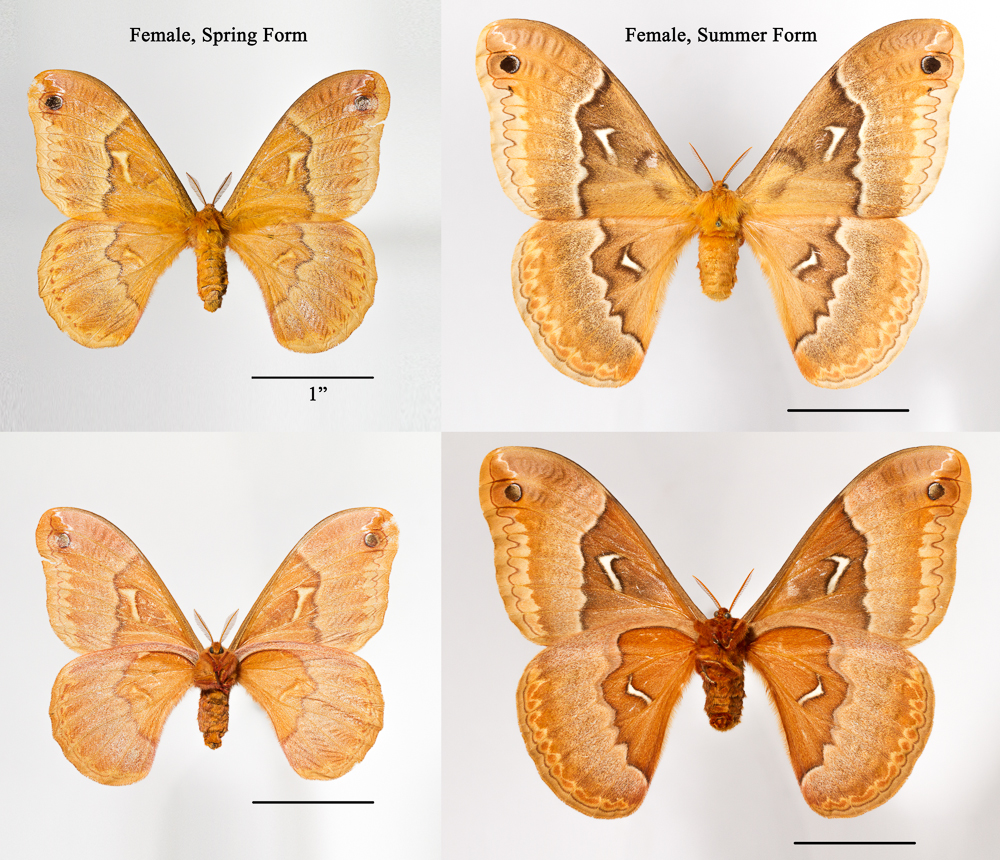Taxonomy
Superfamily:
Family: Subfamily: Tribe: P3 Number: MONA Number:
Comments: One of three Callosamia species in North Carolina, all of which overlap in range in the North Carolina Coastal Plain. As discussed by Ferguson (1972), C. securifera had long been considered just a form or subspecies of C. angulifera , a view that persisted even after differences in host plants, habitats, and other features had been carefully described. Brimley (1938) appears to have been one of the lumpers, only including C. angulifera in his list of species for North Carolina even though he himself had reared at least one specimen (from Wendell) from a cocoon collected from Sweetbay. This specimen, a male, is now in the NCSU Insect Museum and, apart from an odd reddish color on the wings appears to represent C. securifera (one of the few specimens from the Piedmont).
Identification
Field Guide Descriptions: Covell (1984) Online Resources: MPG , BugGuide , iNaturalist , Google , BAMONA , GBIF , BOLD Technical Description, Adults: Forbes (1923), Ferguson (1972), Tuskes et al. (1996)Technical Description, Immature Stages: Forbes (1923), Ferguson (1972), Tuskes et al. (1996); Wagner (2005)
Adult Markings: Strongly sexually dimorphic: males are dark umber shaded with pale gold and females are more generally yellowish to golden and variably shaded with umber. The pattern and coloration of both sexes overlap particularly with those of the Tulip-tree Silkmoth (C. angulifera). Examination of the underside of the hindwing offers the most reliable way to distinguish them (Ferguson, 1972). In securifera -- males and females -- there is less contrast between the large dark patch in the basal and medial portion of the wing and the submarginal area just beyond the postmedian line (Ferguson, 1972); in angulifera the submarginal area is much lighter in color, varying from whitish to pinkish. In securifera, the postmedian line, which is black, is bordered by a grayish-brown line over most of its length whereas in angulifera it is typically bordered by a bright white or pinkish line (Covell, 1984). Other differences include the size of the discal spots, particularly on the hindwing, which are usually smaller in securifera or even absent. However, some specimens of angulifera, particularly males of the summer brood, can also have reduced spots on the hindwing. In general, good quality photographs showing the underside of the hindwing are needed to confirm some individuals. One other thing to note, however, is that male securifera fly only around mid-day and nearly all males seen at night, including at lights, represent angulifera.
Adult ID Requirements: Identifiable from good quality photos of unworn specimens.
Immatures and Development: As in the adults, larvae of these two species are very similar (larvae of C. promethea are easier to distinguish) and are best distiguished based on the host plants; those found on Sweetbay are highly likely to be securifera, while those on Tulip-tree are highly likely to be angulifera. Cocoons of securifera, like those of C. promethea but unlike angulifera, tend to stay attached through the winter and are usually easy to spot into the following spring; as with the larvae, association with Sweetbay helps to confirm their identity. Cocoons of securifera are typically much wider and bulkier than those of promethea, which are also usually found on a different set of host plants.
Larvae ID Requirements: Identifiable from good quality photos, especially where associated with known host plants.

 »
»


 »
»
